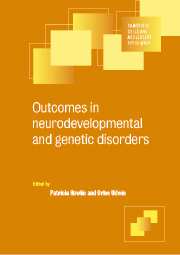Book contents
- Frontmatter
- Contents
- List of contributors
- Preface
- 1 Attention deficit hyperactivity disorder
- 2 Developmental language disorders
- 3 Reading and other specific learning difficulties
- 4 Metabolic disorders
- 5 Hemiplegic cerebral palsy
- 6 Autistic disorders
- 7 Down syndrome
- 8 Fragile X syndrome
- 9 Prader-Willi and Angelman syndromes: from childhood to adult life
- 10 Rett disorder
- 11 Tuberous sclerosis
- 12 Williams and Smith-Magenis syndromes
- Index
8 - Fragile X syndrome
Published online by Cambridge University Press: 13 August 2009
- Frontmatter
- Contents
- List of contributors
- Preface
- 1 Attention deficit hyperactivity disorder
- 2 Developmental language disorders
- 3 Reading and other specific learning difficulties
- 4 Metabolic disorders
- 5 Hemiplegic cerebral palsy
- 6 Autistic disorders
- 7 Down syndrome
- 8 Fragile X syndrome
- 9 Prader-Willi and Angelman syndromes: from childhood to adult life
- 10 Rett disorder
- 11 Tuberous sclerosis
- 12 Williams and Smith-Magenis syndromes
- Index
Summary
Introduction
Fragile X syndrome (FXS) is caused by a trinucleotide (CGG)n repeat expansion in the fragile X mental retardation 1 (FMR1) gene which is located near the end of the long arm of the X chromosome. Although by now over 200 genes have been identified on the X chromosome in which a mutation leads to learning disabilities, fragile X is the most common cause of X-linked learning disabilities, representing 30% of these disorders (Sherman, 1996). Fragile X also causes learning and emotional problems without mental retardation, indicating a very broad spectrum of involvement in this disorder.
Prevalence figures for FXS are complicated, as there have been new ways of diagnosing the syndrome, and different populations have been screened for this disorder. Before the FMR1 gene was discovered in 1991 (Verkerk et al., 1991), FXS was identified through cytogenetic testing, which revealed a fragile site near the end of the long arm of the X chromosome in affected individuals. However, other mutations besides the FMR1 mutation have been discovered which lead to a fragile site at this location. Although early cytogenetic studies suggested a prevalence figure of close to 1 per 1000 in the general population, more recent DNA studies of the CGG repeat element in the FMR1 gene have demonstrated that approximately 1 in 4000 males and 1 in 6000 females in the general population have learning disabilities caused by FXS (Turner et al., 1996; de Vries et al., 1997).
Keywords
- Type
- Chapter
- Information
- Outcomes in Neurodevelopmental and Genetic Disorders , pp. 198 - 219Publisher: Cambridge University PressPrint publication year: 2002
- 84
- Cited by

